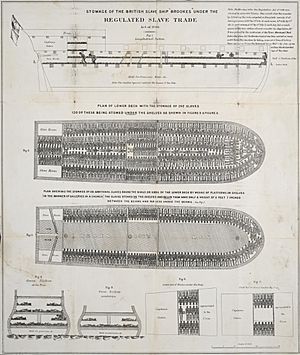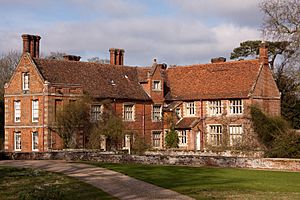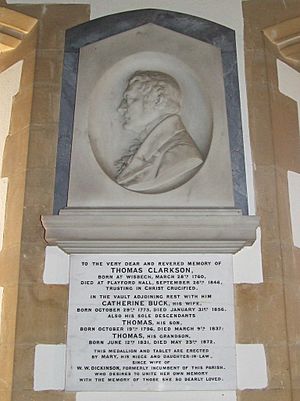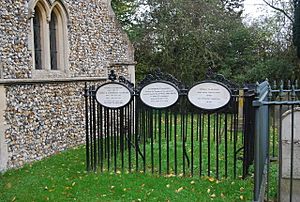Thomas Clarkson facts for kids
Quick facts for kids
Thomas Clarkson
|
|
|---|---|

Thomas Clarkson by Carl Frederik von Breda, painting in the National Portrait Gallery
|
|
| Born | 28 March 1760 Wisbech, Isle of Ely, Cambridgeshire, England
|
| Died | 26 September 1846 (aged 86) Playford, Suffolk, England
|
| Nationality | English |
| Alma mater | St John's College, Cambridge |
| Known for | Abolitionism |
| Relatives | John Clarkson, brother |
Thomas Clarkson (born March 28, 1760 – died September 26, 1846) was an English activist. He played a huge role in ending the slave trade in the British Empire. He helped start a group called the Society for Effecting the Abolition of the Slave Trade. This group worked to stop the buying and selling of enslaved people.
Clarkson also helped pass the Slave Trade Act 1807. This law made it illegal for Britain to trade in slaves. Later in his life, he worked to end slavery all over the world. He was a key speaker at the first British and Foreign Anti-Slavery Society meeting in London in 1840. This meeting aimed to end slavery in other countries.
Contents
Early Life and Education
Thomas Clarkson was born in Wisbech, England. His father was a priest and a school headmaster. Thomas went to Wisbech Grammar School and then to St Paul's School, London.
In 1779, he started studying at St John's College, Cambridge. He was a very good student. He planned to become a priest, like his father.
Discovering the Horrors of Slavery
In 1785, Clarkson entered an essay contest at his university. The topic was: "Is it right to make people slaves against their will?" This question changed his life.
Clarkson read many books about slavery. He also talked to people who had experienced the slave trade. He learned about the terrible things that happened to enslaved people.
After winning the essay prize, Clarkson had a powerful moment. He felt a strong calling to fight against slavery. He decided to dedicate his life to this cause.
He published his essay in English in 1786. It was called An essay on the slavery and commerce of the human species. This essay helped him meet other people who wanted to end slavery. Many of these people were Quakers.
In 1787, a group of people formed the Committee for the Abolition of the Slave Trade. This group included Clarkson and other important figures like Granville Sharp. They wanted to convince the British Parliament to stop the slave trade.
Fighting Against Slavery
Clarkson became a key leader in the Committee for the Abolition of the Slave Trade. His job was to gather proof against the slave trade. He traveled all over England to do this.
He faced strong opposition in some cities. For example, in Liverpool, a major slave-trading port, he was attacked. He barely escaped with his life.
Clarkson talked to 20,000 sailors to get their stories. He collected tools used on slave ships. These included iron handcuffs, leg-shackles, and thumbscrews. He also found instruments used to force open slaves' jaws. He showed these tools at public meetings to shock people.
He also visited a ship called The Lively. It carried beautiful goods from Africa, like carved ivory and fine textiles. Clarkson was amazed by the skill of the African people who made these items. He realized that people who could create such things should not be enslaved. He started collecting these items to show that Africans were skilled artisans. He argued for fair trade instead of slave trade.
Clarkson wrote many pamphlets against the slave trade. He filled them with real stories from sailors and doctors. These writings helped William Wilberforce give his first speech against slavery in Parliament in 1789.
Olaudah Equiano, a former enslaved African, also published his life story. Clarkson helped promote Equiano's book. This book was very important in the anti-slavery movement.
In 1791, Wilberforce tried to pass a law to end the slave trade. But it was defeated. Clarkson continued to travel and write. He got a drawing of how enslaved people were packed onto a ship called the Brookes. He published this image and used it in his lectures. This image showed the terrible conditions on slave ships.
For many years, Wilberforce tried to pass the law, but it failed. The war with France also made it harder to debate the issue.
By 1794, Clarkson was very tired and sick. He took a break from his work. He moved to the Lake District and became friends with the poet William Wordsworth.
In 1796, he married Catherine Buck. They had one child, Thomas. They later moved to Playford Hall in Suffolk.
When the war with France ended, Clarkson returned to the fight in 1804. He traveled all over Britain again, asking for support. He worked hard to convince Members of Parliament to vote for the law.
Finally, in 1807, the Slave Trade Act was passed. This law ended the slave trade in the British Empire. Britain also used its navy to stop illegal slave ships. Clarkson then worked to end the slave trade in other countries, like Spain and France.
Later Years and Global Fight

In 1823, a new group was formed: the Anti-Slavery Society. Clarkson traveled again to gain support for ending slavery completely. He covered 10,000 miles! His efforts led to many petitions being sent to Parliament.
In 1833, the Slavery Abolition Act was passed. This law finally ended slavery in British colonies. Enslaved people became free on August 1, 1838.
Clarkson lived for 13 more years. Even with failing eyesight, he kept fighting for abolition. He focused on the United States, where slavery was still common. In 1840, he was the main speaker at the first World Anti-Slavery Convention in London. This meeting aimed to end slavery around the globe.
In 1846, Clarkson met Frederick Douglass. Douglass was an American former slave who had escaped to freedom. He became a famous activist. Douglass was very grateful when British friends helped buy his freedom.
Clarkson's Family and Death
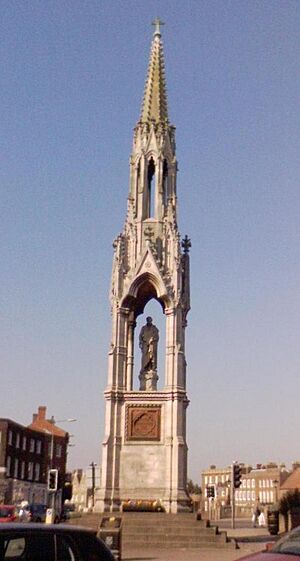
Thomas Clarkson's younger brother, John Clarkson, also played a big role in the anti-slavery movement. John helped about 1200 former enslaved people move from Nova Scotia, Canada, to Africa in 1792. They settled in the new colony of Sierra Leone and founded Freetown. John Clarkson became its first Governor.
Thomas Clarkson died on September 26, 1846, in Playford, Suffolk. He was buried there.
Today, the Clarkson chest and collection of anti-slavery items are on display at the Wisbech & Fenland Museum.
Clarkson's Legacy
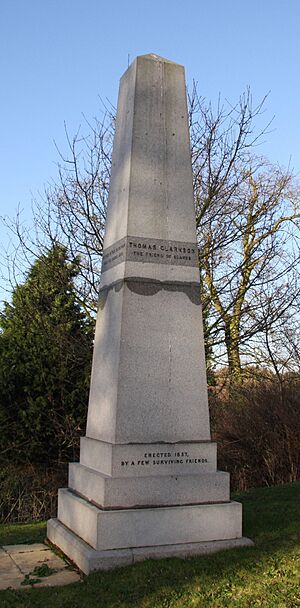
Thomas Clarkson is remembered for his tireless work against slavery:
- In 1833, a portrait of Clarkson was painted for Wisbech Town Hall.
- In 1834, a town in Jamaica was named Clarksonville in his honor.
- In 1839, he was given the "Freedom of the City of London."
- In 1839, a mission station in South Africa was named Clarkson.
- The Wisbech & Fenland Museum has a permanent display of items he collected.
- In 1857, a monument was built for him in Playford churchyard.
- In 1879, another monument was put up in Wadesmill. It marks the spot where he decided to dedicate his life to ending the slave trade.
- The Clarkson Memorial was built in Wisbech in 1881. The Thomas Clarkson Academy in Wisbech is named after him.
- A special plaque in Westminster Abbey honors his memory.
- Several roads in the UK are named after him.
- In 2007, he appeared on a UK stamp.
- The Church of England honors Clarkson on July 30 each year.
Clarkson in Art and Film
The famous poet William Wordsworth wrote a sonnet about Clarkson. It celebrates his success in ending the slave trade.
In the 2006 film Amazing Grace, which tells the story of the fight against the slave trade, Thomas Clarkson was played by actor Rufus Sewell.
See also
 In Spanish: Thomas Clarkson para niños
In Spanish: Thomas Clarkson para niños
- Aborigines' Protection Society
- Clapham Sect
- List of abolitionist forerunners
- List of people granted honorary French citizenship during the French Revolution


